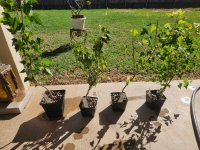Just not seeing why I shouldn't take it out now.
A question you should ask yourself is what do you want this tree to look like in its “finished” state. Once you set out your general goals, you can start to map out a path to get there. Specifically, how tall do you want the tree to ultimately be? Let’s assume one foot for discussion. The ultimate height of the tree can now guide you on how thick the trunk should be - some general guidance is a ratio of 1:6 to 1:12 of trunk thickness at base to height. Let’s assume you want 1:6 again for discussion - so you will want a 2 inch trunk for your 12 inch tree.
Fastest way to get thickening is to grow the tree freely. So one way to proceed is to let the tree grow wild for a few years to thicken it up. The purpose of this growth is get lots of foliage to perform photosynthesis and produce sugars - more sugars, more and faster thickening. In short, much of this growth is just “sacrifice “ growth - it’s there to power thickening and will be cut off when the time is right.
In these initial years of growth, maintaining a cute little tree is not the goal - in fact it is counterproductive if the goal is to obtain growth.
So your tree has grown wild for years and is now about 2 inches thick - now what? You chop it back!!! Perhaps it’s several feet tall at this point. You wanted a 12 inch tree, so what happens if you cut your tree back to 12 inches? Well, your 12 inch tree will be 2 inches thick from bottom to top - you have a thick branch, not a trunk with taper. Taper is an essential feature of creating a realistic tree, so this will never do.
You will need to cut lower than 12”, in fact chopping back to about 1/3 of the anticipated final height is a good rule of thumb. So after growing the tree really tall for years, the next step is to get it down to about 4” tall and start to grow the next section of trunk. This process of growing wild and cutting back will be repeated again and again to create additional sections of trunk that are progressively thinner than the ones below creating taper.
These chops are also a great place to create movement in your tree as the new leader (new section of trunk) can be grown out on an angle.
These are just general guidelines to express the concept of growing for thickening and cutting for taper and movement. I like to look at pics of bonsai and find trees that I appreciate. These give me guidance on what is possible for any given piece of material I get my hands on.
Looking at your tree, it has a very thin trunk at this point and its lower section is rather straight (also, is it grafted???). It needs time to grow, build up foliage and thicken. You seem to be focused on the “handles”, but perhaps you will be chopping this tree below the handles - maybe once you get your proper thickness, maybe earlier?

